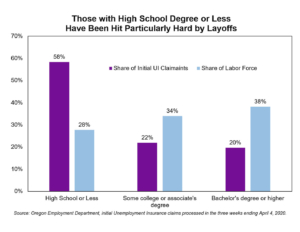
Coastal and Central Oregon counties that depend on tourism have the highest layoff rates in the first three weeks since Governor Brown issued a stay-at-home order leading to widespread business closures. Initial claims in that period reached nearly 270,000.
As late as February, Oregon’s unemployment rate stood at 3.3 percent. Some economists predict the state’s jobless rate could reach as high as 20 percent as a result of the COVID-19 outbreak and public health response. Nationally, some 22 million workers find themselves out of work.
An analysis of Oregon Employment Department unemployment claims show 20 percent of them were filed by workers in the accommodation and food service sector and 12 percent in the arts, entertainment and recreation sector. Claims by construction workers accounted for 8 percent of filings, real estate and rentals 6 percent and manufacturing 5 percent. Despite coronavirus-related demands, health care and social assistance employment represented 6 percent of claims.
“There are many health-related businesses that are not serving on the frontlines of the COVID-19 response such as dentist offices, ambulatory health services, medical labs and surgery centers,” Damon Runberg, an economist at the Employment Department, noted in a blog analyzing initial claims.

Runberg says 58 percent of the initial unemployment insurance claims were filed by Oregonians with a high school diploma or less, even though that cohort only represents 28 percent of the state’s workforce. Oregonians with some college or an associate degree accounted for 22 percent of claims, while making up 34 percent of the workforce. As expected, college graduates fared the best, accounting for 20 percent of claims and representing 38 percent of the workforce.
Runberg also provides an age distribution of those filing unemployment claims. The hardest hit segment are workers between 25 and 34 years of age who total 30 percent of claimants, but only a 23 percent share of the state’s workforce. Workers between 35-44 account for 23 percent of claims, just a nudge higher than their 22 percent of the workforce. Older workers from 45 to 65 and beyond and younger workers from 16 to 24 filed claims at lower percentages than their workforce shares.
By number, the largest number of initial claims were filed by workers in the Portland metropolitan area – 29,140 in Multnomah County and 13,940 in Washington County. Claims filed in Lincoln and Clatsop counties each represented 10 percent of the state’s total labor force. Deschutes County claims totaled 8 percent of the total workforce. Even though its number of claims was large, Multnomah County’s claims only represented 6 percent of the total state workforce.
In his blog, Runberg said three weeks of initial unemployment insurance claims is sufficient to begin to assess the impact of layoffs on different regions and economic sectors in the state.
“Not surprisingly, the most populated counties have the largest number of initial unemployment insurance claims processed,” he writes. “However, we can see a clearer picture of the hardest hit counties by looking at the number of initial claims as a share of the total labor force. Here we see that counties with large accommodation and food service sectors and tourism destinations were the hardest hit.”



